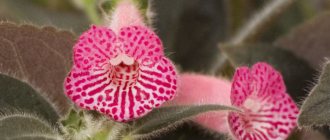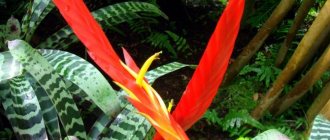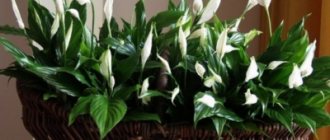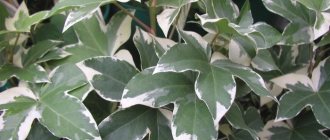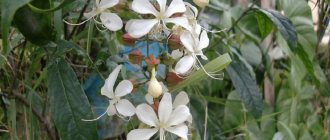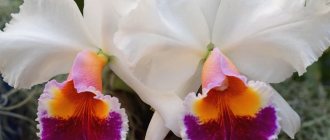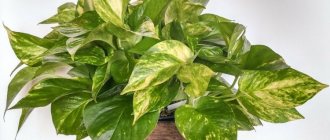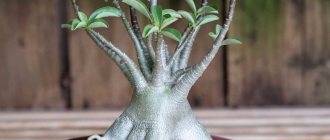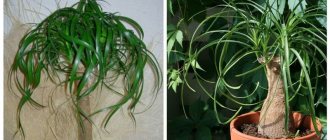Pilea is a herbaceous plant or shrub from the Nettle family. Unites about 400 species, can be either annual or perennial.
Homeland - Southeast Asia and Vietnam. Unpretentiousness, endurance, variety of species and varieties, luxury of small decorative foliage, ease of propagation - all this characterizes Pilea, which can be grown even by novice gardeners.
The height of the pilea reaches 35-45 cm. The intensity of its growth is very high: in one season, a plant grown from a cutting reaches the size of an adult. The stems of the flower are highly branched and can creep. Leaves with pronounced veins grow alternately on shortened petioles.
Depending on the type, they can be leathery and rough or miniature and smooth, velvety or glossy, have jagged or smooth edges. The color of the leaf blade varies from green and light green to brown and crimson, with multi-colored veins, stripes and spots.
Pilea blooms with small, inconspicuous flowers collected in racemose inflorescences.
| It grows very quickly. |
| It blooms very rarely in summer. |
| The plant is easy to grow. |
| Up to 4 years, then should be rejuvenated. |
Caring for Pilea at home. Briefly
| Temperature | In summer 19-23 degrees, in winter 15-17, but not lower than 10 degrees. |
| Air humidity | High. |
| Lighting | Pilea at home needs bright, diffused light; east or west window. |
| Watering | Moderate; in summer 2-3 times a week, in winter 1 time a week. |
| Priming | Medium fertile with a neutral or slightly acidic reaction, permeable to water. |
| Feeding and fertilizer | During the growing season, apply liquid complex fertilizer once every 2 weeks. |
| Transfer | Once a year, in spring in wide pots. |
| Reproduction | Stem cuttings. |
| Features of cultivation | Does not tolerate drafts well and needs pruning and pinching. |
Caring for Pilea at home. Details
Pilea care at home does not require too much care. She doesn't notice occasional mistakes, but she won't forgive serious mistakes. Therefore, in order to enjoy the lush decorative foliage as much as possible, it is important to create suitable conditions for it.
Bloom
In apartment conditions, Pilea blooms extremely rarely.
Usually buds appear in summer. Inconspicuous monochromatic flowers are collected in racemose inflorescences in the axils of the leaves. They have no decorative value.
Temperature
The maximum temperature for Pilea is 25 degrees, the minimum is 10 degrees. The optimal thermometer readings in summer are 19-23 degrees, in winter 15-17 degrees. If it is not possible to organize a cool winter, it is important to take care of good lighting at this time.
Pilea is afraid of drafts and sudden temperature changes - this can lead to the death of the flower. The pot with the plant should be located away from the windows and the door to the balcony.
Spraying Pilea
Pilea at home prefers high environmental humidity.
However, it is not recommended to spray it, especially species with velvet foliage. Spots may remain on the leaves, they lose their decorative appearance, wither or dry out. To increase air humidity, you can take the following measures:
- Use a humidifier;
- Place the pot in a tray with damp pebbles, moss or expanded clay. In this case, the bottom of the pot should not touch the water;
- Place a container of water near the plant: as it evaporates, it will increase the humidity.
Lighting
For the full development of the Pilea, bright, diffused light is required.
The optimal place is an eastern or western window sill. On the south side, the plant will need shading using a translucent curtain. Or the pot can be placed on the nightstand near the south window. Otherwise, direct rays of the sun may cause burns on the leaves. In winter, due to lack of light, variegated varieties may lose the brightness of their leaves and their stems may become elongated. With short daylight hours, the plant can be moved to a southern windowsill. It would not be superfluous to additionally illuminate the flower with phyto- or fluorescent lamps for 8-12 hours.
Watering
Pilea needs regular moderate watering in spring and summer (2 times a week) and rare (once every 7-10 days) in winter.
Between moistenings, the top layer of soil should dry out a little. If we talk about extremes, the pilea tolerates drought better than waterlogging. The latter is fraught with withering and fading of the leaves, and rotting of the roots. The plant responds better to frequent but meager watering than to rare and abundant watering.
Water for irrigation should be left to settle for several days; it should be at room temperature.
Pilea pot
Since Pilea has a shallow root system, the pot should be shallow (no higher than 10 cm) and wide. Unusual flowerpots or decorative trays will do.
The pot must match the size of the plant. If you choose a pot that is too large, the likelihood of soil acidification and rotting of the root system increases.
Soil for Pilea
Pilea grows well in fertile, loose soil with medium or weak acidity (5.5-6 pH). A store-bought substrate for decorative foliage plants is suitable. If you have the opportunity to prepare the mixture yourself, you can choose one of the options:
- leaf soil, humus, peat and sand in a ratio of 2:2:1:1;
- greenhouse soil, peat and perlite in equal parts;
- turf soil, leaf soil, peat, sand, expanded clay (1:1:1:1:1/2).
Before planting, it is recommended to disinfect the prepared mixture by spilling it with a weak pink solution of potassium permanganate.
Homemade Pilea also grows well in hydroponics.
Feeding and fertilizer
Due to a lack of nutrients, Pilea slows down its growth, and its leaves become smaller and lose their decorative properties.
It is recommended to fertilize throughout the year: in spring and summer – once every 10-15 days, in winter – once a month. Complex liquid fertilizers for decorative foliage plants are suitable. Concentration - according to instructions.
Fertilizers should be applied after watering to moist soil so as not to burn the root system.
Pilea transplant
The optimal time for transplantation is from early spring to mid-summer. Plants are replanted once a year.
If necessary, the bushes are divided. To maintain a decorative appearance and compactness, the pilea is cut off before transplanting, and the tips of the shoots are pinched. When transplanting, it is important to lay a 3-centimeter layer of drainage at the bottom of the pot. Crushed brick, expanded clay or pebbles are suitable for this purpose.
Pilea quickly degenerates: it stretches out, loses its compactness, and the stems become exposed. Therefore, it is recommended to update it by cuttings. Some perform the procedure annually, others once every 2-3 years. The reference point is the appearance of the plant: if it has lost its attractiveness, rejuvenation is necessary.
Trimming
Since the Pilea flower at home grows quickly and branches heavily, it requires annual pruning. The procedure is optimally carried out at the beginning or end of the growing season (beginning of spring or autumn).
To make the plant lush and compact in size, the tops of the shoots are regularly pinched. The cuttings remaining after pruning can be used to propagate the flower.
Rest period
Pilea does not have a clearly defined dormant period. Like most indoor flowers in winter (from November to February) it stops growth and development. Does not require special care during this period.
Watering
Watering can only be done with soft water that has stood for several days. In spring and summer, the frequency of watering depends on the speed of drying of the top soil; the rest of the time you should wait a few days. Do not spray the Pilea - excess moisture on the leaves can cause them to fall off.
If you are going on vacation
The best way to preserve your Pilea while you are away is to find someone to take care of them. But if this option is not possible, then there are several ways to prevent the flowers from drying out:
- water the flowers generously before leaving;
- remove the pots from the windowsill and draw the curtains;
- wrap the pots in damp newspaper and place the plant in cellophane;
- trim the buds, thin out the leaves;
- place flowers closer to each other to retain moisture longer;
- buy or make automatic watering;
- use capillary mats.
Pilea propagation
When propagated at home, Pilea is propagated by cuttings.
The procedure can be carried out throughout the year, but the optimal time is spring: the pilea takes root faster and grows with young shoots.
Cuttings 7-10 cm long with 2-3 pairs of leaves are suitable for propagation. They should be planted in sand or adult plant substrate and covered with polyethylene or glass. The “greenhouse” is placed in a warm place, protected from direct sunlight, regularly ventilated and watered. When the cuttings have taken root and new leaves have appeared, the polyethylene or glass is removed.
Freshly cut cuttings can be placed in water, and when they have roots, they can be planted in individual pots. You can plant 2-3 cuttings in one container - such a bush will be more lush.
Diseases and pests
Pilea is a fairly hardy plant. However, if the basic rules of caring for it are not followed, difficulties may arise. Here are the main problems and the reasons for their occurrence:
- The lower leaves of the Pilea fall off - incorrect watering regime (excess or lack of moisture).
- Pilea leaves turn black - the temperature is too low.
- Pilea leaves droop - insufficient watering.
- Pilea shoots are stretched - lack of sunlight.
- Drying spots appear on the leaves - these are burns due to direct rays of the sun hitting the plant.
- The lower parts of the branches become bare - the bush is degenerating and needs rejuvenation.
Among the pests, Pilea can be affected by aphids, scale insects, spider mites, and thrips.
Room temperature
This culture belongs to heat-loving plants. The most optimal air temperature range is between 20-25 degrees. For some subspecies, experts recommend lowering the air temperature to 18 degrees in the winter months (due to the characteristics of metabolism).
It is important to protect the plant from drafts, but summer air baths are very useful for active growth.
Types of Pilea domestica with photos and names
Pilea peperomioides
Forms a compact bush, up to 45 cm high. On a rigid stem, rounded leaves on long petioles are placed oppositely. The leaf blade, up to 7 cm in diameter, is smooth, green in color, and slightly bent inward.
Cadie's Pilea, Silver Pilea (Pilea cadierei)
A bushy plant, up to 40 cm high. Young stems are erect, mature stems lean towards the soil and branch strongly. The leaves have an elongated oval shape, up to 5 cm wide, up to 20 cm long. The green leaf plate with three veins has two silvery lines along it. Small flowers are collected in axillary inflorescences.
Pilea microphylla
Perennial herbaceous plant, up to 15 cm high. Arched light green shoots are highly branched. They have many miniature light green leaves, up to 0.5 cm long, placed opposite them. The leaf blade is glossy, oval or round in shape. In the axils of the leaves, tiny flowers, both unisexual and bisexual, are collected in corymbose inflorescences.
Pilea filamentous (Pilea numiralifolia)
An ampelous plant with thin reddish shoots. Small rounded leaves, up to 1 cm long, are alternately placed on them. The underside of the leaf plate is painted purple.
Pilea involucrata
A herbaceous plant with erect or creeping stems, up to 30 cm high. The opposite leaves are oval in shape and have pronounced serrated edges. Their length reaches 7 cm. The leaf plate is tuberous, light green in color, and brown in the area of 3 longitudinal veins. This species is used to create hybrids.
general description
"Pilea coinifolia" is a tropical plant. In its homeland, South America, it lives in shaded areas of tropical forests that have enough moisture. In indoor floriculture it is used as potted, ampelous and ground cover, for planting together with large, upright species of indoor flowers and trees.
This species is the shortest, with creeping stems and small leaves 1 cm in diameter, similar to coins. Thanks to these properties, it is popularly called the “Japanese dollar.” The surface of the leaves seems to be quilted, the color on top is green. And below is red-purple. The stems of this species are also reddish, in combination with the green foliage, they give “Pilea Monetolifolia” a special decorative appearance.
